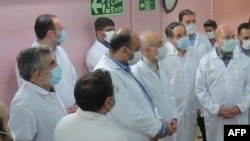Iran has begun enriching uranium to 60% purity at its Fordow nuclear plant and plans a vast expansion of its enrichment capacity, the U.N. nuclear watchdog said on Tuesday, detailing the latest acceleration of Iran's atomic program over Western objections.
The International Atomic Energy Agency (IAEA) was confirming Iranian reports of Tehran's step, taken in retaliation for the agency's criticism of Iran in a Board of Governors’ resolution last week.
While Iran is already enriching uranium up to 60% purity elsewhere, its decision to do so at Fordow is likely to be viewed by Western nations as particularly provocative because the site is buried under a mountain, making it harder to attack.
That purity is below the roughly 90% needed for weapons-grade material but well above the 20% Iran produced before its 2015 agreement with major powers to cap enrichment at 3.67%.
The latest move is in retaliation to last week's resolution by the IAEA's 35-nation Board of Governors ordering Iran to cooperate with the agency's years-long investigation into the origin of uranium particles found at three undeclared sites.
"Director General Rafael Mariano Grossi today said Iran had started producing high enriched uranium – UF6 (uranium hexafluoride) enriched up to 60% – using the existing two cascades of IR-6 centrifuges in the Fordow Fuel Enrichment Plant, in addition to such production that has taken place at Natanz since April 2021," the agency said in a statement.
It was summarizing a confidential report to IAEA member states seen by Reuters on various moves taken and planned by Iran at enrichment plants at Fordow and Natanz.
Centrifuges
Iran only has six cascades, or clusters, of IR-6 centrifuges in operation at three plants at Fordow and Natanz. Diplomats said the IR-6 is the most advanced model it is using on such a scale.
It plans to add 14 more IR-6 cascades at Fordow, six of which will replace first-generation IR-1 machines, the IAEA said. They will enrich to up to 5% or up to 20%, it added.
In the longer term, however, Iran plans an expansion of its underground, commercial-scale Fuel Enrichment Plant at Natanz, where it is also installing and bringing online more cascades of advanced centrifuges.
"Iran continues to advance its enrichment activities at the Fuel Enrichment Plant in Natanz and now plans to install a second production building, capable of housing over 100 centrifuge cascades," it said.
The 2015 nuclear pact between Iran and six world powers lets Iran use only first-generation IR-1 centrifuges but, as the deal unraveled after then-U.S. President Donald Trump ditched it in 2018, Tehran has installed cascades of more efficient advanced centrifuges, such as the IR-2m, IR-4 and IR-6. It has also resumed enrichment at Fordow, which was barred under the deal.
U.S. officials declined to confirm that Iran was enriching to 60% at Fordow, repeating their preference to use diplomacy to curb Iran's nuclear program but saying all options – code for possible military action – were available to U.S. President Joe Biden.
The IAEA resolution is the second this year targeting Iran over the investigation, which has become an obstacle to talks on reviving the 2015 deal because Iran demands an end to the probe.
Indirect U.S.-Iranian talks to revive the accord have been stalemated since September.
Iran's crackdown on anti-government protests after the death of a young woman, Mahsa Amini, in custody and its sales of drones to Russia have turned Washington's focus away from reviving a nuclear deal.









